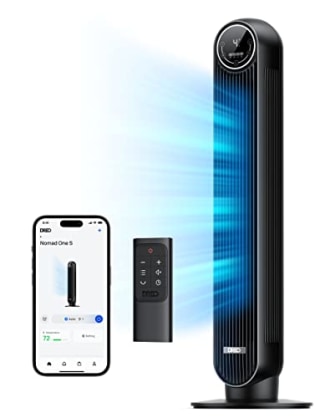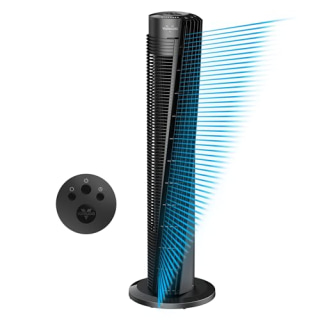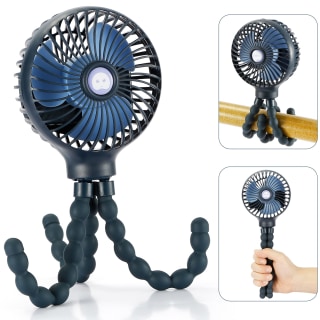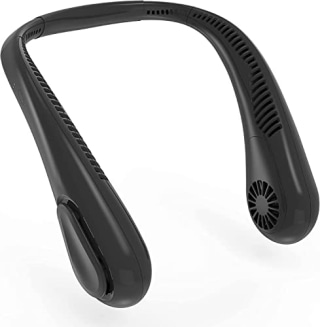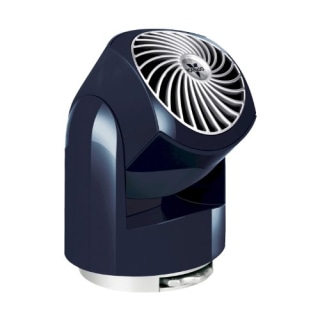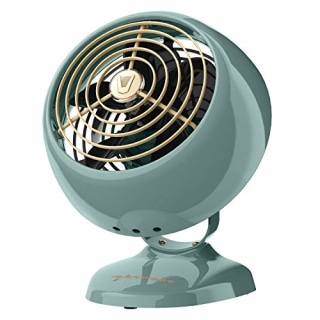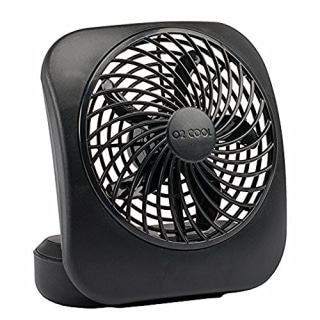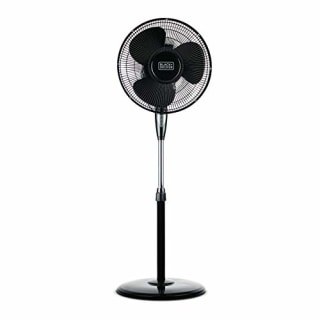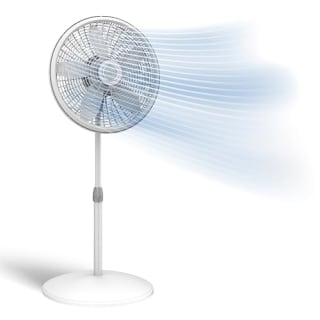If you don’t have an air conditioner or want to reduce your time using the one you do have, a fan is a great alternative. And its benefits extend beyond helping you regulate a room’s temperature, says Carl Prouty, tech expert at Abt Electronics.
“[Fans are] much quieter than window or wall air conditioners and they use far less energy, so their operating costs are much lower,” he says. They’re also often more portable than air conditioners, so you can easily move them between rooms and bring them on the go.
Want more from NBC Select? Sign up for our newsletter, The Selection, and shop smarter.
How I picked the best fans
I talked to an expert about how to decide between various styles and highlighted features to consider while shopping. I also rounded up a handful of fans across styles and price points according to expert guidance.
- Fan type and size: Deciding which type of fan to purchase largely depends on where you’re using it and how large a space you want to keep cool. Size also matters—bigger fans will circulate air throughout rooms, while smaller fans might just cool you down.
- Fan speeds: If you like to adjust the intensity of airflow coming from your fan, consider purchasing one with multiple speeds so you have options.
- Oscillation: This refers to the fan’s ability to circulate air across a room. If you’re trying to cool down a larger space, oscillation can help.
- Price: More expensive fans tend to have more bells and whistles, while lower-priced options are usually more basic in design.
Best fans to keep you cool
To help guide your shopping, I highlighted a handful of the best fans across various styles, including larger fans designed to cool entire rooms, tabletop and handheld options for personal use. For each model, I pointed out specs that might aid in narrowing down the best options, including oscillation, smart features, types of filters, modes and more.
Best tower fans
Built with an 8-hour timer, this fan has a hidden handle you can grip around your home. The fan also has a touchscreen display, which allows you to switch between modes easily. To help you eliminate dust accumulating over time, the fan comes apart so you can reach all its nooks and crannies.
This tower fan has a twisted vent, which allows air to circulate in your room without constant oscillation. Plus, you can choose from four strengths and eight timing options. NBC Select commerce editor Cory Fernandez has used a Vornado tower fan for years and loves how strong it is. “It’s actually surprisingly powerful for a tower fan,” he says. “It keeps me cool on super hot and humid summer days.”
Best personal fans
This portable fan has three flexible legs that you can bend and wrap around beach umbrellas, shelves, strollers and more. You can also stand it up and place it on a flat surface. The fan has a rechargeable battery and you can choose from three fan speeds.
This personal neck fan is a favorite of NBC Select reporter Zoe Malin. “This fan may be small, but it’s powerful. Even on the lowest setting, it blows a steady stream of cool air toward my face and neck,” says Malin. The Comlife neck fan has three airflow speeds, and you can also adjust the airflow angle by twisting the silicone piece at the back of your neck. Depending on which airflow speed you choose, a full battery gives you between three and a half to nine hours of use, according to the brand.
Best desk fans
My office tends to get hot in the morning, so I keep this on my desk to cool me down. It takes up minimal space, but it’s very powerful. I like the adjustable tilt head and manual swivel base, which allow me to angle the fan perfectly in my direction. I bought this fan years ago and it’s still as good as new.
Vornado also offers a retro, vintage-looking fan with an adjustable tilted head so you can easily change the airflow direction.
This small fan is great for keeping on your desk at work during the summer or on any chair outside. The fan can fold flat when it’s not in use and it has a built-in handle. You can also manually adjust the fan’s angle.
Best window fan
You can install this two-fan system in your window, just like an air conditioner, except it’s much lighter and easier to secure. The fan comes with a remote to control the temperature and speed setting. The fan also comes with adjustable panels on the side, so you can ensure it fits in your window properly.
Best pedestal fans
This is built with an auto timer that shuts the fan off after 7.5 hours. You can also adjust its height and tilt angle. There are three speed settings and an LED display to help you keep track of your preferred fan speed and rotation settings.
While this fan is a more basic, low-tech option, reporter Harry Rabinowitz says it works well, and he’s used it for years. The fan is designed with a tilt-back head, allowing you to direct airflow upward or downward if you’d like to. It also has a wide base for stability.
Best ceiling fan
This ceiling fan, designed with five blades, also has a built-in dimmable light. If you get too cold, the brand says you can reverse the fan’s blades to push warm air (which tends to rise to the top of rooms) downward. You can mount the fan in either a straight or angled position.
Types of fans to consider
When shopping for the right fan, decide whether to cool off yourself or a whole room. Household fans are usually needed when a space doesn’t have air conditioning or a central air system. On the other hand, handheld fans are ideal for personal use, especially for travelers, those who work outside or want a burst of cool air while on the move.
Here are the fan types you should know about, as well as the purpose of each:
- Ceiling fans are permanently installed on a room’s ceiling. They move air around to keep rooms cool — during colder months, you can often reverse the airflow to circulate warm air. In addition to indoor ceiling fans, you can purchase models specifically designed for outdoor use on porches or under pergolas. Some also incorporate lights.
- Tower fans — sometimes called floor fans — are portable units designed to move from room to room. They’re tall and narrow, so you can usually fit them in small spaces.
- Window fans sit in window frames, similar to air conditioning units. However, experts told us they use less energy and are easier to set up than window AC units. They bring in cold air from outside and are often more effective than traditional fans at cooling larger spaces. Remember that window fans must be removed when it gets cold out and can cause leaks when it rains.
- Desk fans are personal fans that attach to or stand upright on tables. Since you can also place them on top of a counter, bedside table or end table, you might also see them referred to as table fans. You can put these next to you while working, sleeping or watching TV on the couch.
- Pedestal fans are designed similarly to desk fans, but their base is at ground level. Stand-up fans are typically larger and taller than desk fans and create a stronger breeze, though they’re still portable.
- Handheld fans are another type of personal fan. Due to their small size, they won’t cool you off as well as other options, but they’re convenient since they’re cordless and portable.
How to shop for fans
Once you decide what type of fan you’re interested in, consider whether the following features are important. Identify your must-haves in a fan and look for models that include those features.
- Remote controls: You can adjust the settings wherever you are in a room.
- Smart features: Some models have Wi-Fi compatibility, while others pair with a companion app, which allows you to control the fan, review air quality and usage reports and more from your phone. Fans may also connect to voice-activated smart devices for hands-free use.
- Filters: Similar to air purifiers, some fans come with filters that can remove allergens like dust or pet hair. For example, you may see fans built with HEPA filters, which pull out tiny particles from the air, or charcoal filters, which can eliminate odors. Before purchasing a fan, consider how often you’ll need to replace the filter and how much the replacement filters cost.
- Oscillation: This refers to a fan’s ability to move from side to side or up and down, thus moving air in multiple directions across a room. This helps the fan circulate cool air throughout a space instead of directing it into one spot.
- Modes: While some fans only allow you to manually program their settings, others have a variety of modes designed for different circumstances. Some have an auto mode, for example, which can adjust to a room’s air quality or light, and others have a sleep mode that can dim an LED display.
Meet our expert
At NBC Select, we work with experts with specialized knowledge and authority based on relevant training and/or experience. We also ensure that all expert advice and recommendations are made independently and with no undisclosed financial conflicts of interest.
Carl Prouty is a tech expert at Abt Electronics.
Why trust NBC Select?
I am a reporter at NBC Select, where I have been covering home appliances like fans, air purifiers and more for years. For this article, I interviewed an expert in the space and researched dozens of fans on the market.
Catch up on NBC Select’s in-depth coverage of tech and tools, wellness and more, and follow us on Facebook, Instagram, Twitter and TikTok to stay up to date.



